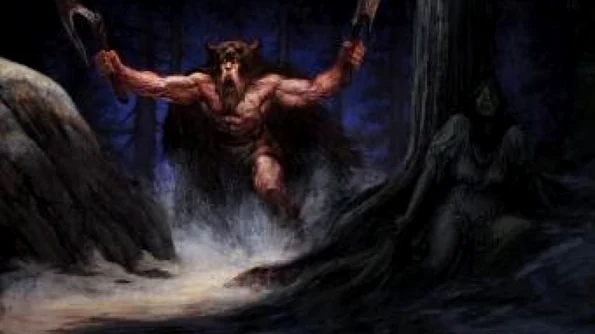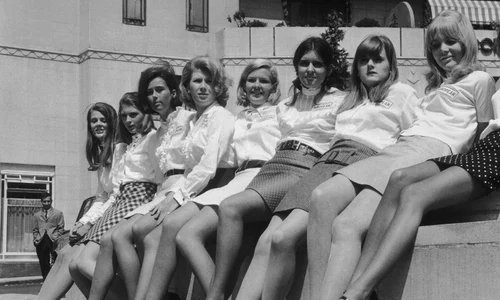
The Wild and Insane Viking Warriors
One of most common historical mystifications is that of the Vikings. They are mostly represented as ferocious fighters, lacking any cultural background, the ultimate destroyers raiding everything in their path. True savages. While that is more a product of fantasy based more on literary than historical traditions, there seems to have been some sort of category which may have augmented the myth.
The Vikings were after all a civilization that held the warrior cult in high esteem, and the feats of the great warrior, brave and heroic, is a recurring theme in all sagas. Beyond the exaggerations that equate the Vikings with bloodthirsty monsters, there seems to have existed a very particular category of warriors, one who has common ground with our own modern depictions of these men. They were wild, unchecked and on the rampage, known as the berserkers.
He term may stem from bare-sark, meaning “shirtless”, according to their habit of engaging in combat without wearing any armor. Ynglingasagaspeaks of this habit, telling that Odin’s warriors didn’t make any use of chain mails and acted like savage dogs and wolves.
Another hypothesis relates the term to bear-sark, meaning the animal skin they used to wear. Grettir saganames the warriors serving King Harald “wolfskin”, a metaphor also occurring in Vatnsdaela Sagaor Hrafnsmal. Berserkers invoke through their behavioral example the king of the gods himself, Odin, who in Adam of Bremen’s opinion stands for rage. His Germanic name, Wotan, is rooted in the Old Norse odur, which in modern German turned into Wut, fury. This fact brings to our attention the terrifying madness of the warrior who actually becomes a symbol for Odin himself, if we also think about the god’s capability of adopting an animal appearance, what the berserkers also craved for.
Berserkers could assimilate the animal features of wolves and bears as well, and here we have as examples some heroes like Kveldulfr from the Sagaabout Egil Skallagrimsson, or Bjarki in Hrolf saga, who during battle literally turn into beasts, spreading fear and terror around them. Georges Dumezil calls the phenomenon hamingja(soul, spirit) or fygja(a state of the soul), a particular trance of the warrior. Another odinic quality shared by berserkers is magical immunity to arms. In Havamal, Odin resorts to all sorts of spells to induce this type of immunity. Stories recount that sometimes berserkers possess this ability from birth, the resistance to arms being related to their animal metamorphosis which offers them the gift of the protective skin. In Vatnsdaela Saga, Vikings wear wolf skins that prevent any wounds to be inflicted upon them, skins more enduring than chain mail. The concept of immunity may have evolved as a consequence of the fighters’ rage and madness, since in their state of martial ecstasy they may not have felt the wounds either.

The berserker could have been a real member of a special cult dedicated to Odin, and only its members must have been acquainted to its cultic practices. We do however have some fugitive references. For instance, Constantine the 8th, in his Book of Ceremonies, speaks about a ritual dance involving his Varangian Guard, who used to wear animal skins and masks, highly probably a ritual not very far away from the mythological information about the berserkers. This type of dance is often represented iconographically on helmets, scabbards or armbands, illustrating men covered in furs and with animal heads.
Other ritual practices described in literature refer to the initiation of youngsters in such bands of mad warriors, usually comprising 12 men. Another characteristic of these groups is the name of the leader, usually Bjorn or some other derivative, meaning “bear”. The process of initiation presupposed a real or simulated battle with a bear. We have one example in Grettirsaga, where Bjorn, the leader of the berserker band, throws away Grettir’s cloak in the bear’s den, and he must subject the animal to regain it. In Hrolf saga, Hjalti, Bjarki’s protégé, fulfills a similar mission, just that this one time the battle is symbolic, with the skin of an already slain beast.
There were some voices who suggested the idea that the Vikings would feed on hallucinogenic mushrooms, for example Amanita muscaria, which triggered a certain wild trance, or their behavior was caused by illnesses like epilepsy or hysteria. Mushrooms nonetheless more likely weaken the organism, and the other cases are rarely documented. One must rather take into account some mythological categories that explain and justify the preference for military skills and qualities possibly induced by means of the ritual practices cherished by berserker clans, aiding to an identification of the warrior with the almighty god, leading to the idea of a beastly metamorphosis.
The image of the berserker must be that of terror incarnate. Dumezil draw a parallel between these bands and the tribe of the Harii mentioned by the historian Tacitus, who not only utilized their natural ferocious appearance but also body paint in order to cause fear among the enemies. It is a gesture similar to wearing skins to suggest the superhuman quality of the berserker.
We find out quite a lot about the transformation of warriors into wolves in the Egil sagaor Völsunga Saga. In the latter, Sigmundr and his son Sinfjolti steal the skins of some berserkers so they can turn into beasts and rampage the forests. Berserkers are often very ugly and sometimes mistaken for trolls, as it occurs in the case of Skallagrim, Egil’s father. Egil himself was thought to be dark-haired and as ugly as his father, and on one occasion, at king Athelstan’s banquet, he turned into something so bad-looking that the king gave him a golden ring to diminish the fury controlling him. The hero Ogmundr in Örvar-OddSagahas a similar look:black hair covering all of his face and one can barely see his eyes an teeth.

Berserkers would enter a state of trance known as the berserker gang, described in sagas as beginning with tremors, then chattering, face swelling and skin color changing. The warriors started howling like wild beasts and killing everything in their way, friend or foe, benefiting from an incredible force. As long as the trance lasted, they had no shade of reason or judgment, but at its end they felt exhausted, as if they had just suffered from a major disease. Egil Sagarecounts that Skallagrim became entranced while his son was playing with another child, whom he crushed to the ground. Had it not been for a maiden’s help, Egil would have also been killed. The extraordinary strength of these men is a recurring theme in the sagas, berserkers usually being compared to giants or trolls.
Moreover, their force can be expressed through names, derivatives from the word meaning “bear” Gerbjorn, Gunbjorn, Arinbjorn, Esbjorn, Thorbjorn. Saxo Grammaticus informs us that in order to gain their strength, berserkers might as well drink the blood of a wolf or bear. Upon leaving the state of trance, the warrior is at the peak of his weakness. That is why the stories tell that the best way to kill one is particularly in this moment, following the example of Hjalmar and Odd from Herverar Saga.
Going beyond the mythologization in the literary works, the berserkers most likely represented a series of clans or orders carefully used by kings precisely because of their capacity to self-induce a state of extreme violence. They were admired as well as despised because they could easily betray their comrades. Basically they were used as shock troops, such as in the case of kings Harald or Halfdan who hires them, and Dumezil believes that their special connection to Odin must have counted since the god stand for the attribute of sovereignty as well. Beside this role in the army as auxiliary troops, berserkers are more than often the villains of Norse stories, the bloodthirsty brutes.
Saxo Grammaticus, mentioning such a band, tells that the warriors took the villages by storm, shed so mush blood and bragged with their conquests, even considering them honorable. The sagas mention that they were erotically insatiable as well, abducting women the good heroes had to save.
The wild berserkers are therefore a special category of fighters, at the borderline between history and myth. Anyway, their story is probably the one cementing the myth of Viking savagery. They are first mentioned in Haraldskvaedi (Hrafnsmal), a poem dating from the 9thcentury which the scald Thornbjorn Hornklofi dedicates to the first king of Norway, Harald. This king has in his service an elite group, the ulfheonars, those covered in wolf furs. Norse texts describe them as frenzied hybrids, loyal servants of Odin with whom they share some features, underlining the totemic connection between them and the animals that give them strength.
If we are to red Tacitus we might guess it was in fact an old structure in the Germanic tribes. More accurate is the date this military association was declared illegal, that is the year 1012, when king Erik also forbid the duels, holmganga. Berserkers would challenge someone to a duel, and upon defeating them, would come into the fortune of the defeated. They would nonetheless not disappear that easily. But in 1123 the Icelandic legislation inspired by the newly arrived Christian faith, condemned anyone engaged in such activities to exile. The phrenetic berserkers, as well as their chief Odin were condemned to dissolution by the new order.
Further reading:
Beard, D. J, "The Berserkr in Icelandic Literature”, Approaches to Oral Literature, Ulster, 1978;
Dumézil, G., The Destiny of the Warrior, Chicago, 1970;
Eliade, M., Samanismul şi tehnicile arhaice ale extazului, Bucureşti, 1997;
Höfler, O., "Berserker." Reallexikon der Germanischen Altertumskunde, Berlin, 1976.















